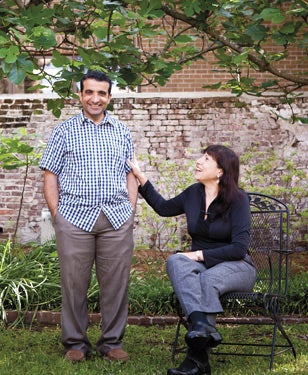
WE’VE ALL HEARD THE STORIES – THE reports of violence, conflict and general unrest in the Middle East. For over a century, we’ve watched the news and read the articles about a region always struggling, always on the brink of crisis. It’s the same old story. Time and time again.
But we’re not getting the whole story. We’re not getting the tastes of the paper-thin, unleavened bread. We’re not getting the sounds of the high-pitched, celebratory ululation. We’re not getting the smells of the fortune-revealing Turkish coffee. We’re not getting the dancing, the pop stars, the theater, the poetry. We’re not getting the people.
That’s another story. And that’s the story that Israeli Naomi Gale and Palestinian Ghazi Abuhakema want to tell.
“The Middle East is the people. The people who laugh, reason, think and cry. That is the voice of the majority that you do not hear. That’s the real story,” says Abuhakema, assistant professor of Asian studies, who typically teaches Arabic language and culture. “This is the story that we are telling: the story of the people of the Middle East. We are two narrators. We have real insight. We are uniquely qualified storytellers.”
Indeed, having the inside story is a clear advantage for Abuhakema and Gale, who this spring co-taught the course, Cultures of the Middle East, highlighting religion, family structures, gender relations, literature, music and cinema of the region. That advantage wasn’t lost on their students.
“They say they are lucky to be in the class,” says Gale, a Schusterman Visiting Professor of Israel Studies. “They say it’s the first time they have been taught by people who live it. It gives it more authenticity for them, I think.”
It also gave them another first: This is the only course in the country co-taught by an Israeli-Palestinian team. Although they are from different perspectives, they share a history and a culture, and have a lot to teach each other.
“That has been part of the experience for us,” says Abuhakema, who grew up in a refugee camp, where both his parents were buried and three of his brothers and their families still live. “We’re learning from experiencing each other.”
“For me, it is a fantastic experience,” agrees Gale, who also stayed in a camp when her family was stripped of their Iraqi citizenship and forced to move to Israel. “We are getting to know each other for our personalities, as people. When people meet and work together, there is humanization, because you get to know the person.”
As they know, you can’t really understand a story without getting to know its characters. And, as witnesses to these two characters getting to know each other, students got a good understanding of the story of the Middle East.
“If you look out at the students, you can see it on their faces, you can read that they are really learning. For them, this is new. I think they are into it,” says Abuhakema. “I like the feeling that the students are learning something about me – that I can give a piece of myself to them. It’s a great feeling, because in the future, this will broaden their horizons, it will widen their perspective – change the way they see the world. This will help them open that window.”
“It’s just a little opening to the Middle East,” agrees Gale, noting that what the course covers “is just the tip of the tip of the tip of the iceberg.”
Sure, in some ways, the course has to make a long story short, but the one it tells is so much more than that same old story we’ve always heard. It’s one of warmth, of beauty, of tradition and – most important – of people.




